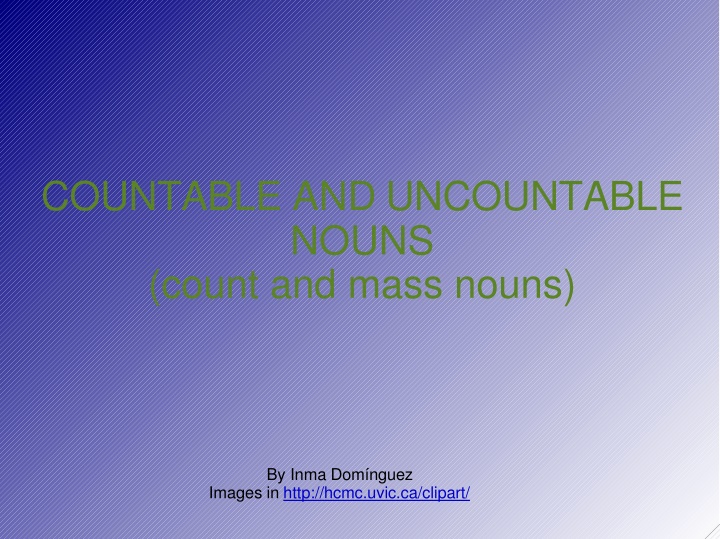
Countable and Uncountable Nouns: A Complete Guide
Learn about countable and uncountable nouns, their differences, and how to quantify uncountable nouns using partitives. Discover examples and guidelines for proper usage, including quantifiers and when to use articles. Enhance your grasp of English grammar effortlessly.
Download Presentation

Please find below an Image/Link to download the presentation.
The content on the website is provided AS IS for your information and personal use only. It may not be sold, licensed, or shared on other websites without obtaining consent from the author. If you encounter any issues during the download, it is possible that the publisher has removed the file from their server.
You are allowed to download the files provided on this website for personal or commercial use, subject to the condition that they are used lawfully. All files are the property of their respective owners.
The content on the website is provided AS IS for your information and personal use only. It may not be sold, licensed, or shared on other websites without obtaining consent from the author.
E N D
Presentation Transcript
COUNTABLE AND UNCOUNTABLE NOUNS (count and mass nouns) By Inma Dom nguez Images in http://hcmc.uvic.ca/clipart/
COUNTABLE AND UNCOUNTABLE NOUNS COUNTABLE NOUNS They refer to things that can be counted: UNCOUNTABLE NOUNS They refer to immaterial concepts: life, love,... They refer to stuff or liquid that cannot be counted: water, sugar, salt, ... A banana A cherry bread jam icecream A Christmas tree
COUNTABLE AND UNCOUNTABLE NOUNS COUNTABLE They can be singular or plural an apple UNCOUNTABLE They are always singular coffee milk money pasta some apples
COUNTABLE AND UNCOUNTABLE NOUNS COUNTABLE Before them you can use: A/an a house The the table Numbers two children Some /any (when they are plural only) There are some apples on the table UNCOUNTABLE Before them you can use: Some/any There is some water in the glass There isn't any cheese on the table But you can't use: a /an or numbers before them.
Quantifiers COUNTABLE Many UNCOUNTABLE Much There are many children in the park Few /a few There isn't much sugar in my coffee. Little / a little There are few apples (not enough). They know little English (not enough to manage) They know a little English (enough to manage) How much There are a few apples (enough). How many How many apples do you want? How much money do you need?
How to count uncountable nouns: the use of partitives Uncountable nouns can be quantified using some expressions called partitives. We use partitives when we refer to a part of a whole. There are many different partitives. Here are some examples: A glass of water A bottle of whisky A tin of soup A piece of cheese A cup of coffee A carton of milk A jar of jam A tube of toothpaste A bag of crisps An item of news A loaf of bread A can of coke A bar of soap We can use numbers before the partitives: two cups of coffee, ten bottles of whisky, ...















